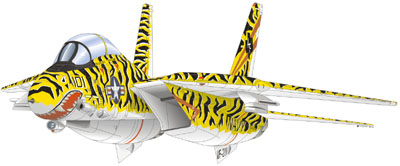
|
F-14 Paint Schemes Artwork by Torsten Anft From 1970 until the early 1980's the F-14s were painted on the top surfaces with a light gull gray (FS 16440) and on all underside and control surfaces with white (FS 17875). These were the days of high-visibility colours in the US Navy and squadron insignias were bright as were the national insignias (insignia red (FS 11136), insignia blue (FS 15044). Anti-glare panels were black (FS 37038), non-skid walkways dark gull gray (FS 36231), some radome and rain erosion coatings were painted with radome tan (FS 33613). Bare metal areas without any paint were the leading edges of wings, stabilizers, fins and edge of intake ducts (lower portion) as well as the blast shield in front of the gun port, the engine area and the engine nozzles.  Whenever Tomcats undergo major overhauls, it is done at the Naval Aviation Depot Norfolk,
Virginia. After such an overhaul procedure, a new painting is applied to the aircraft. Paint
information about externally applied finishes & coatings is included in form of a small
Tomcat badge, usually
applied to the outside of the starboard vertical tail. When the F-14
returns to the fleet, this small badge is usually removed when individual squadron colours are
applied to the aircraft.
Whenever Tomcats undergo major overhauls, it is done at the Naval Aviation Depot Norfolk,
Virginia. After such an overhaul procedure, a new painting is applied to the aircraft. Paint
information about externally applied finishes & coatings is included in form of a small
Tomcat badge, usually
applied to the outside of the starboard vertical tail. When the F-14
returns to the fleet, this small badge is usually removed when individual squadron colours are
applied to the aircraft.
The F-14 prototypes and NASA Tomcats were painted in the gray over white colours, too and several surfaces of the wings and tail were painted with bright red-orange colours. Furthermore, a green/light brown/dark brown over white colour scheme was applied to the 80 F-14s delivered to the Iran.  Thereafter the colours began to vanish from Navy aircraft, the white surfaces were toned down and the squadron colours became gray and dull. In the mid-1980's the F-14s were painted in an overall light gull gray (FS 16440). US national insignias were either bright and colourful or also dark gull gray. Bare metal areas remained the same as on earlier Tomcats. In the late 1980's until today, the Navy adopted the low-visibility colour schemes as shown below. National insignias are nearly invisible due to the smudgy gray-colours. Also, the former red and yellow rescue arrows and warning areas became dark grey. But after several years of gray-only F-14s the squadrons rediscovered their bright-coloured insignia and today a number of F-14s appear in a combination of low-visibility paint scheme and high-visibility squadron insignia.  Interior colours: Air intakes are white until the first fan stages. Front areas (as deep as the the lower air intake lip) are painted with the same colour as the lower surface of the air intake. Landing gear bays and inside of landing gear bay doors are white. Edges of landing gear doors are red. Cockpit interior is mainly grey, except the instrument panels. Inside of air intake bleed air doors is white. Additionally, in the late 1970's a few F-14s (VX-4: 159827/"41", 159829/"43", 159830/"44", 159831/"45"; VF-1: 158979/"NK100"; VF-2: 158985/"NK200"; VF-124: 159827/"NJ410"; PMTC: ??????/"201"; VF-101: 161135/"AD102" slightly different Ferris colours in 1981) were temporarily painted in the so-called Keith Ferris camouflage scheme (see below). For this deceptive paint system three gray colours were applied in a serrated scheme (matt dark gray (FS 36118, dark gull gray (FS 36231) and light gull gray (FS 36440)).  And sometimes, when an exercise was on schedule, some squadrons painted their F-14s with water-soluble dark green and brown colours (at least VF-11, VF-74, VF,124, VF-211, VF-213 (see F-14 Photo section)). Today there fly a few special coloured F-14s at the Navy Fighter Weapons School (see F-14 Sqaudron and F-14 Photo sections), wearing the colours of Russian Sukhoi Su-27s or Iranian Tomcats for adversary air combat training. Also, a few VF-74 F-14Bs received a special two-tone grey colour scheme for adversary training just prior to the squadron's disestablishment (see F-14 Squadron and F-14 Photo section). Individual squadron tail markings differed from time to time, especially when changing the Air Wing. A selection of squadron markings and a list of two-letter Tailcodes for each Air Wing can be found in the chapter about F-14 squadrons. |
Top of the page |
F-14 Tomcat Walk-Around Details:
4-Side View |
Access Panels |
AGM-88 HARM |
AIM-7 Sparrow |
AIM-9 Sidewinder |
AIM-54 Phoenix F-14 Tomcat: Other Topics: Start Page Foreword FAQ Updates Copyright © by Torsten Anft |